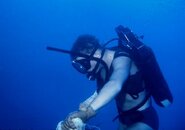Basking Ridge Diver
Contributor
Hey Errol - you have a basic mistake or typo... should be (100/33)+1 = 4
Gas Consumption Rate
An average diver has a surface consumption rate (SAC) of .75 cubic feet per minute. This means that on the surface a diver would use ¾ a cubic foot of gas per minute. To determine how much they would use at depth, you have to multiply by the ATA. At 100 the ATA is (100/3) + 1 = 4 so .75cft/min x 4ata = 3 cubic feet per minute consumed on the bottom. We presumed a 20 minute bottom time so we will use 3cft/min x 20 minutes = 60 cft.
And not everyone subscribes to this - most of us have an emergency issue we are heading up and not hanging around waiting to see if we can fix it... This one has been beaten to death just saying this is not how everyone is going to prepare for an emergency ascent. For my diving I chose to use a pony.
Should an emergency happen on the bottom, it is likely that it will take you and your buddy a minute to sort it out and prepare to ascend. As we saw above, it will take approximately 7 minutes to ascend so that is a total of 8 minutes. As we learned an average diver will consume 3 cubic feet per minute at 100 feet without being stressed. For practical purposes, a dive team with an out of gas emergency will probably have an increased SAC rate so to increase the rate from .75 to 1cft/min is reasonable. For the ascent portion you would take the SAC times the average depth (in this case the average depth between maximum depth and the surface which is 50 or 2.5ATA) Therefore, to plan gas for this out of gas diver ascent you take 8 minutes ascent time x 2 divers x 2.5 SAC = 40 cubic feet which is referred to as Minimum Gas. Therefore, a diver must depart the bottom when they have 40 cubic feet remaining. Using an Aluminum 80 that means when the pressure gauge reads 1600 psi it is time to ascend!
Gas Consumption Rate
An average diver has a surface consumption rate (SAC) of .75 cubic feet per minute. This means that on the surface a diver would use ¾ a cubic foot of gas per minute. To determine how much they would use at depth, you have to multiply by the ATA. At 100 the ATA is (100/3) + 1 = 4 so .75cft/min x 4ata = 3 cubic feet per minute consumed on the bottom. We presumed a 20 minute bottom time so we will use 3cft/min x 20 minutes = 60 cft.
And not everyone subscribes to this - most of us have an emergency issue we are heading up and not hanging around waiting to see if we can fix it... This one has been beaten to death just saying this is not how everyone is going to prepare for an emergency ascent. For my diving I chose to use a pony.
Should an emergency happen on the bottom, it is likely that it will take you and your buddy a minute to sort it out and prepare to ascend. As we saw above, it will take approximately 7 minutes to ascend so that is a total of 8 minutes. As we learned an average diver will consume 3 cubic feet per minute at 100 feet without being stressed. For practical purposes, a dive team with an out of gas emergency will probably have an increased SAC rate so to increase the rate from .75 to 1cft/min is reasonable. For the ascent portion you would take the SAC times the average depth (in this case the average depth between maximum depth and the surface which is 50 or 2.5ATA) Therefore, to plan gas for this out of gas diver ascent you take 8 minutes ascent time x 2 divers x 2.5 SAC = 40 cubic feet which is referred to as Minimum Gas. Therefore, a diver must depart the bottom when they have 40 cubic feet remaining. Using an Aluminum 80 that means when the pressure gauge reads 1600 psi it is time to ascend!




